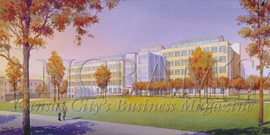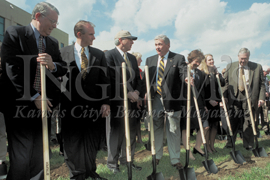ground breaking
MU’s Life Sciences Center


The University of Missouri-Columbia is preparing to add to its long list
of life-science achievements with the coming of a new Life Sciences Center.
Since MU first saved French vineyards from vine-eating insects in the
1870s, it has produced the first soil-erosion study, made significant
advancements in home dialysis and performed the first pediatric angioplasty.
The Life Sciences Center is another step in advancing the school’s
already prominent life-science research environment.
The focus of the center is to allow a place of collaboration for those
researchers working to improve food, health and the environment. The facility
will provide 124,000 square feet of space for 50 faculty researchers,
150 postdoctoral fellows, 200 graduate students and over 450 undergraduates.
Currently these researchers are working toward mapping the corn DNA, regrowing
injured tissue, reducing cancer pain in humans and animals, generating
hydrogen from pond scum for fuel, assessing the benefits and risks of
herbal supplements, producing transgenic pigs as a possible organ donor
for humans and more. The Life Sciences Center will provide a central location
for any number of researchers working together and sharing their knowledge.
The center is under construction this fall and is projected to open in
2004. The $60 million project will include 50 research laboratories, equipment
rooms, five teaching laboratories and a 250-seat auditorium. The central
room of the facility will be a sky-lit atrium that connects the research
laboratories, class rooms and work areas.
Outreach is a key aspect of the building design, reflecting the importance
of partnerships with other research centers, government institutions and
the private sector. State-of-the-art technology will allow for connecting
video-display monitors to off-sight research facilities or other institutions.
The MU Life Sciences Center will also feature videos and art representing
the facility’s research.
Principal funding for the project has been split between the state ofMissouri—$50
million, NASA—$29 million, and the Health Resources and Services
Administration—$1 million. NASA Administrator Daniel Goldin was on
hand for the groundbreaking on Sept. 8 to sign a Memorandum of Understanding
that solidified the administration’s intent to work with MU to complete
the new research center. Other officials attending were National Science
Foundation Director Rita Colwell, Sen. Kit Bond and Gov. Bob Holden.
“We are very excited about this wonderful addition to our campus
where scientists and their students will share energy and knowledge to
improve the world’s food, health and environment—the three primary
areas of concern for the world of tomorrow,” said Richard Wallace,
MU Chancellor. “We are greatly indebted to everyone who helped make
this dream a reality. With this building, MU will make a major leap forward
towards achieving world leadership in the life sciences in the 21st century.”
Faculty and students from the following academic divisions will combine
their skills in the research laboratories: Agriculture, Food and Natural
Resources, Arts and Science, Engineering, Human Environmental Sciences,
Medicine, Nursing and Veterinary Medicine. The combination of MU’s
past achievements in the life sciences, the potential of its nationally
and internationally known scientists, and the new highly advanced research
facility promises to keep MU a forerunner in life-science research.